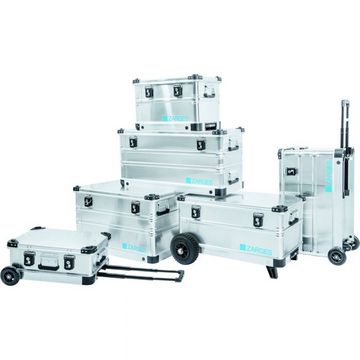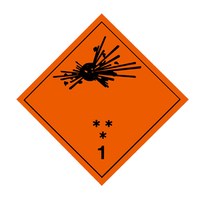Transport and shipping of hazardous goods
When transporting hazardous goods, it is necessary to protect the lives and health of humans and animals as well as to prevent any danger to public safety and order. A set of international regulations have been designed to ensure the safe transport of hazardous goods.
Definition of hazardous goods according to Wikipedia: "Hazardous goods are solids, liquids, or gases that can harm people, other living organisms, property, or the environment."
Solving your transport problems from A to Z: ZARGES offers a comprehensive range of services to help you find the optimal interior and exterior packaging for hazardous goods.
- ZARGES has its own test centre for type-approval testing of hazardous goods packaging.
- Having an authorised test centre means that ZARGES is able to perform tests on hazardous goods packaging and apply for type approvals.
There is no compromise when it comes to safety and protection.
Hazardous goods containers made of aluminium – ZARGES hazardous goods packaging.
In comparison with other materials, hazardous goods packaging made of aluminium combines many benefits. It is highly sturdy and resistant while having low deadweight, is very durable and can therefore be used many times, can be closed securely, and offers optimal protection even under extreme conditions.
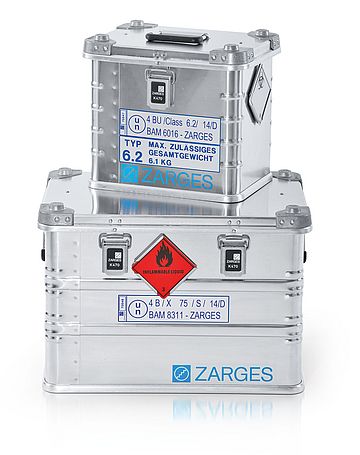
Why choose hazardous goods packaging made by ZARGES?
Choose between safe and safer.
At ZARGES, you can choose from a wide range of sizes and models. Our own test centre, which is recognised and monitored by BAM (German Federal Institute for Materials Research), carries out specimen tests in order to obtain approvals such as UN 4B, UN 4BV and UN 50B in a quick and uncomplicated manner.
A large selection of accessories and inserts ensure that you will find a comprehensive protection for transporting your hazardous goods.
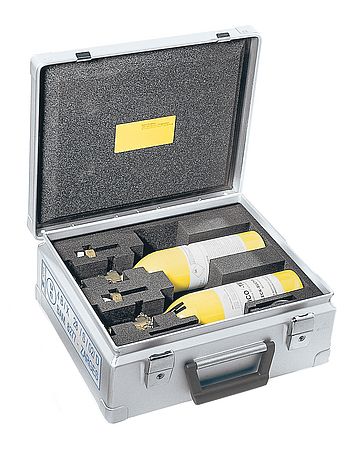
ZARGES hazardous goods packaging at a glance
K 470 universal case – GGV
When used in combination with an internal packaging made of plastic or glass, the K 470 universal case can be used as a container approved for the transport of liquid and solid hazardous substances.
The distinguishing feature of the containers in this series is the maximum permissible gross weights. It has been tested as composite packaging and approved as UN 4B packaging.
We work together with leading suppliers to offer you a comprehensive range of accessories that can turn the K 470 aluminium case into a hazardous goods container that complies with regulations. These include, for example, liquid-tight bags, padding materials and absorbent materials.
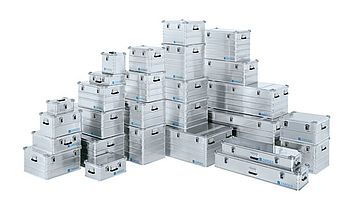
Accessories
Frame for warning signs
- For holding hazard signs.
- Stainless steel design.
- On request.
Label frame
- In various sizes in accordance with German industrial standard or in special sizes.
- On request.
Absorbent material
- Absorbent material Vermiculite, grain size 3 - 6 mm, packed dust-tight in cushions.
- Dimensions (L × W): 300 × 200 mm, Filling 200 g Absorbency: 600 ml
Order No. 61 963 - Dimensions (L × W): 500 × 200 mm, Filling 400 g Absorbency: 1200 ml
Order No. 61 964
ZARGES K 424 XC mobile box
The K 424 XC is equipped with built-in castors and is available in six sizes. Underneath the sturdy aluminium box is an additional support frame that houses both the telescopic handle and the castors. The mobility-enhancing solution enables heavy loads to be transported effortlessly by just one person – even on rough or sandy terrain if the box is fitted with the optional pneumatic tyres.
The K 424 XC with approval for carrying dangerous goods (GGV) is an ergonomic solution for transporting dangerous goods and substances.
Details and features
- Highly durable
- Optimal mobility thanks to the built-in castors, telescopic handle and a second sprung drop handle on the end face
- Smooth-running wheels
- High load-bearing capacity of up to 50 kg despite its lightweight design
- Optional 125 mm castor set or 220 mm offroad set
- Stackable, with all-round beading for added stability
- Comprehensive range of customisable interior fittings
- Protected against ingress of dust and splash water
Hazardous goods container for contagious substances
ZARGES hazardous goods containers are approved as composite packaging for the transport of potentially contagious substances in accordance with UN numbers 2814 (contagious substance that dangerous to humans) and 2900 (contagious substance that is dangerous only to animals), Category A and B, with any mode of transport. The containers have passed more-stringent tests, such as drop tests from a height of 9 m.
Cases of all sizes in the K 470, BY and Alu Case series can be used for the transport of hazardous substances listed under UN number 3373 (biological substance, Category B). Dry ice or other coolants can be used for temperature-controlled transport.
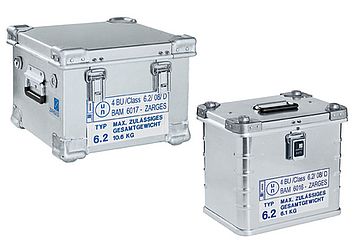
Accessories
PE bag with slide-type seal
- Can be used as sealed internal packaging for ZARGES hazardous goods containers.
- Leakproof in combination with the use of absorption material.
- Mandatory for infectious substances which must be packed in accordance with transport regulations P 650 and P 620.
- Easy-to-operate, slide-type seal for quick and simple opening and closing.
- Bag dimensions: 600 x 600 mm, (fits in ZARGES K 470 40677)
- Material: PE, thickness 60 µm
- ZARGES Art. No. 43831
- Packaging unit: 1 carton containing 100 items
K 475 hazardous goods container – GGV
Transport and storage containers in the K 475 series are reusable packaging solutions made to the highest standards. They are designed as moisture-proof protective packaging and are therefore very suitable for use as hazardous goods packaging. The containers are available in standard sizes or special sizes customised to requirements.
By request, K 475 reusable containers can be delivered with special foam inserts, holders and other extra accessories.

BY cases – GGV
Transport and storage containers of the Y series are especially suitable for military applications. Containers of all sizes are stackable. The entire product line is now also available as packaging approved for the transportation and storage of hazardous goods.

Hazardous goods container for explosive substances
Large containers and special containers for Class 1 explosive substances, suitable for a wide variety of uses, e. g. as transport and storage media for guided missiles, missiles, miniature reconnaissance planes and many other applications. Designed and built from high-strength aluminium-alloy sheets and profiles.
Innovative details such as shock absorbers, mounts and handling aids for problem-free, ergonomic and safe handling. These hazardous goods containers are tested and approved as hazardous goods packaging in accordance with UN requirements, i.e. can be transported on public roads.
- Reusable transport containers, e. g. for gas generators, airbag and belt tensioner modules of hazard class 1.
- Weight: approx. 53 kg incl. pallet.
- Maximum permissible load: 524 kg gross, superimposed load: approx. 1000 kg.
- Interior dimensions (L × W × H): 1130 × 730 × 810 mm.
Note: The following are likewise suitable for transporting Class 1 explosive substances: K 470 universal case, K 475 transport and storage container, BY cases, K 410 Alu Case
Do you have any questions concerning our hazardous goods packaging?
Outer packaging for hazardous goods (also known as hazardous materials) available in standard sizes and special sizes with approval; also available are complete packaging for hazardous goods (composite packaging) and special solutions for hazardous goods packaging and transport.
Tel.: +49 881 687-131
Fax: +49 881 687-484
E-mail: special.systems@zarges.de
FAQ: Frequently asked questions about hazardous goods
Here we will be answering frequently asked questions on the topic of hazardous goods. If you have any questions that are not answered here, please contact our hazardous goods packaging specialists!
What hazardous goods are allowed be transported in ZARGES cases?
Hazardous goods transport is regulated by various laws, depending on the mode of transport. The ADR regulates transport by road, and the RID transport by rail. Transport by air is regulated by the IATA DGR. Most dangerous goods are listed in these regulations. The approved dangerous goods containers are also listed alongside the dangerous goods they are allowed to carry. Using the UN number, you can select the packaging that is approved for the substance in question.
What is ADR?
ADR is the abbreviation for the European Agreement concerning the International Carriage of Dangerous Goods by Road, or in French: Accord Européen relatif au transport international des marchandises dangereuses par route.
What is the purpose of the approval for transport of dangerous goods by road?
Hazardous goods packaging requires a type approval which certifies that the containers are tested for leak-tightness and compliance with further specific requirements.
In Germany, new approvals are granted exclusively by the Federal Institute for Materials Research and Testing (BAM).
How should hazardous goods or hazardous goods packaging be labelled?
Hazardous goods have to be clearly labelled during transport and shipping. The process of doing so is known as labelling. The label has to provide information on the composition of the goods being transported as well as the possible hazards associated with it.
Hazard labels have a diamond shape. They must be affixed to the packages and shipping containers and must contain information on the types of hazard associated with the substances being transported.
More information on hazard warning labels can be found e.g. at German Federal Ministry of Transport, Building and Urban Development (BMVBS).
Hazardous goods packaging by ZARGES can be equipped with all necessary hazardous goods labelling and hazard labels.
What is the type approval (and the UN number)?
The approval is a permit for the series production and labelling or an item of packaging for transport of hazardous goods.
What does the number behind the X on the UN approval label mean?
This is the maximum allowable gross weight (outer packaging incl. inner packaging and dangerous goods).
What is the UN number for labelling hazardous substances?
The UN number (see list of UN numbers on Wikipedia) is a four-digit number assigned by the United Nations Committee of Experts on the Transport of Dangerous Goods. The UN number is also called the substance number.
Besides the UN number and the naming and description of a hazardous substance, the Hazardous Goods Database also provides information on what packaging may be used for the transport of the substance in question.
Besides hazard labels, packages containing dangerous goods also have to be labelled with the corresponding UN number.
ZARGES manufactures hazardous goods packaging and hazardous goods containers. Our products have been tested and given the approval (including a UN approval number).
How is the UN approval number structured?
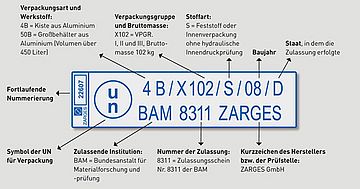
- Packaging type and material of the hazardous goods packaging
- Packing groups X, Y or Z
- Gross weight that the packaging and content must not exceed
- Material type
- Year of manufacture
- Country in which approval was granted
- Approving institution
- Approval number:
- Abbreviation of manufacturer or testing centre:
How do I find the right permissible packaging?
What container you are allowed to use depends on the goods to be transported.
Do ZARGES dangerous goods products have to undergo regular reinspections?
No, because aluminium is not subject to any ageing processes unlike, for example, plastic. A visual inspection of the aluminium cases for external damage is sufficient.
What is the maximum permissible gross weight for the K 470 series of containers?
The maximum permissible gross weights of hazardous goods cases are shown on the respective hazardous goods label. For the K 470 series, this ranges from 26 kg to 200 kg. For special containers the maximum gross weights can be even higher.
Can I transport my hazardous goods directly in ZARGES cases?
No, the cases are approved for use as composite packaging. An insert is always required.
How are hazardous goods and hazardous goods packaging categorised?
Packing groups: Hazardous goods are categorised into three packing groups (I, II and III for high, moderate and low hazard, respectively) that correspond to the performance letters X, Y and Z of hazardous goods packaging. Accordingly, hazardous goods packaging with particular performance letter may only be used for hazardous goods of certain categories.
Types of packaging: The common types of packaging for hazardous goods are drums or barrels, cases or boxes, bags, combination packaging and pressure vessels made of a wide range of materials such as steel, aluminium and other metals as well as wood, cardboard, plastic, fabrics, etc.
Where can I obtain approval certificates for ZARGES hazardous goods packaging?
We will be happy to provide you on request with the approval certificates for our most common hazardous goods packaging. The certificates are also available on the website of the German Federal Institute for Materials Research and Testing (BAM).
When is it necessary to have a hazardous substances officer?
Companies that transport hazardous goods on a daily basis have a hard time dealing with the many different laws and regulations. In the worst case, they may even (unwittingly) become criminally liable. If in doubt, consult a hazardous substances officer or an external hazardous substances consultant. They will be able to advise you on individual cases or draw up an overall concept for you.
